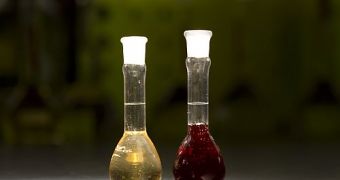Brigham Young University professor Richard Watt and his chemistry students, managed to turn gold into purple, on purpose, thus confirming a new way of harvesting solar power.
They thought of a way they could imitate the reaction between chlorophyll and sunlight, in plants' photosynthesis, and they discovered a common protein that had high chances of reacting with sunlight and produce energy.
For their experiment, they mixed citric acid from oranges with the protein, before dissolving gold powder into the solution.
Then, they exposed the vials containing the yellow-colored mixture to direct sunlight and waited for it to turn purple.
After about 20 minutes, the mixture changed color, which proved that the gold atoms had received electrons and they used the donated energy to group in small, purple-colored nanoparticles.
This means that the protein used sunlight to excite the citric acid and cause a transfer of energy.
While sunlight was successful after 20 minutes, a high-powered tungsten mercury lamp did the job much faster.
Watt said that they “set the system up, turned on the light, and the solution turned purple.
“We knew that we’d proved the concept,” he added.
The success of this experiment opens the way to the next step of the process, which is connecting the protein to an electrode to capture the energy into a battery or fuel cell.
The team's idea is yet another source of inspiration for creating new clean energy sources, and protect the environment.
For the next step of the project, the BYU chemists will partner with Jae-Woo Kim of the National Institute of Aerospace.
Co-authors on the new study include BYU graduate Jeremiah Keyes, grad student Robert Hilton and Jeff Farrer, who runs an electron microscope lab at BYU.
The Brigham Young University experiments are published in the Journal of Nanoparticle Research.

 14 DAY TRIAL //
14 DAY TRIAL //